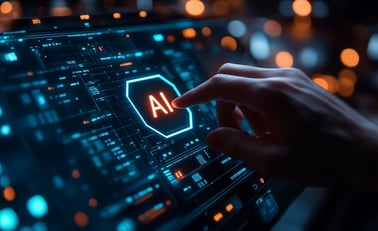In the rapidly evolving landscape of artificial intelligence, the discourse is shifting beyond mere automation to a more profound concept: "AI Agency." This isn't just about computers doing tasks; it's about systems exhibiting increasingly sophisticated levels of understanding, decision-making, and proactive engagement.
There is a clear progression from basic Robotic Process Automation (RPA) to the transformative potential of Agentic AI, promising to revolutionize enterprise intelligence and unlock unprecedented economic productivity.
For years, businesses have leveraged AI to streamline operations, reduce costs, and enhance efficiency. However, the true promise of AI lies not just in automating repetitive tasks but in creating intelligent entities that can adapt, learn, set goals, and operate autonomously. This is the essence of high AI agency, where the next wave of technological innovation is heading.
The Spectrum of AI Agency: From Low to High
The AI solutions can be categorized across a spectrum of agencies, with distinct characteristics defining each stage.

Low Agency: The Realm of RPA
We find Robotic Process Automation (RPA) at the foundational level of AI agency. These systems are characterized by:
- Static: They operate based on pre-defined rules and workflows, lacking the ability to deviate or adapt.
- Reactive: They respond to specific triggers or inputs without proactively initiating actions.
- Tasks: Their focus is on automating discrete, repetitive tasks, such as "Text extract," "Open docs," or "Consolidate data."
- Supervised: They require significant human oversight and intervention to ensure correct execution and address exceptions.
RPA has undoubtedly delivered significant value by automating mundane, high-volume tasks and freeing human employees for more strategic work. However, its limitations lie in its inability to handle variability, context, or complex decision-making, making it suitable only for routine, predictable processes.
Mid-Agency: The Emergence of AI Agents
Moving up the ladder, we encounter AI agents, representing a significant leap beyond traditional RPA. These systems exhibit more intelligent behaviors, often powered by advancements in natural language processing (NLP) and machine learning. New examples include:
- Customer Service Bots with Intent Recognition: While still reactive, these bots can go beyond simple FAQs. They can understand the intent behind a customer's query, even if phrased unconventionally, and route it to the appropriate department or provide a more comprehensive answer, significantly reducing call center volumes for routine issues.
- Personalized Recommendation Engines: Found in e-commerce or streaming platforms, these agents learn user preferences over time and proactively suggest products, movies, or music. While they don't make independent decisions, they exhibit a degree of learning and proactive suggestions based on past interactions.
These agents are a step closer to human-like interaction, offering improved efficiency and customer experience. However, they typically still operate within defined parameters and often require human escalation for nuanced or ambiguous situations.
High Agency: The Promise of Agentic AI
The pinnacle of this spectrum is Agentic AI – a vision of intelligent systems that truly embody the characteristics of high agency. This is where AI moves from being a tool to an active, autonomous participant in complex processes. New examples include:
- Proactive Supply Chain Optimization: Imagine an AI system that constantly monitors global events (weather patterns, geopolitical shifts, labor disputes), analyzes their potential impact on supply chains, and autonomously re-routes shipments, negotiates alternative supplier contracts, or even triggers emergency production shifts to mitigate disruptions before they significantly impact operations.
- Autonomous Financial Portfolio Manager: Beyond simply executing trades, this Agentic AI could continuously analyze global market data, economic indicators, and news sentiment. It would then independently adjust a client's investment portfolio based on their risk tolerance and financial goals, proactively identifying opportunities and mitigating risks without direct human input for routine adjustments. It would only flag truly novel or high-stakes situations for human review.
The defining characteristics of Agentic AI are:
- Adaptive: They can learn from new data, adjust their strategies, and evolve their understanding over time, much like humans do.
- Proactive: They don't just react to inputs; they anticipate needs, identify opportunities, and initiate actions to achieve their goals.
- Goals: They are designed with specific objectives in mind and work autonomously to achieve them, making decisions along the way.
- Autonomous: This is the hallmark of high agency – the ability to operate independently, make decisions, and execute actions without constant human oversight.

The Economic Impact and the Path Forward
The progression from low to high-agency AI directly correlates with increased economic productivity and a potential reduction in cost in the long run. By offloading more complex, adaptive, and autonomous functions to AI, businesses can unlock significant efficiencies, innovate faster, and reallocate human talent to higher-value creative endeavors.
While large language model (LLM) assistants are common, there's still a significant leap to true AI agents. This gap will narrow as we develop methods to build, govern, and trust agentic AI solutions, presenting both major challenges and exciting opportunities.

Governing Agentic AI: As AI systems become more autonomous, the need for robust governance frameworks becomes paramount. This includes establishing clear ethical guidelines, ensuring transparency and accountability in decision-making, and developing mechanisms for human oversight and intervention when necessary. Trust in these autonomous systems is crucial for their widespread adoption.
Conclusion: The Future is Agentic
The journey from static RPA to adaptive Agentic AI represents a fundamental shift in how we conceive and deploy artificial intelligence. It's a move from automating tasks to empowering autonomous, goal-oriented systems that can drive unprecedented levels of enterprise intelligence.
While the challenges of building, governing, and trusting these advanced AI solutions are significant, the potential rewards in terms of economic productivity and transformative business impact are even greater.
As research and development continue to accelerate, the vision of a truly agentic AI future is rapidly becoming a reality, ushering in a new era of intelligent automation and human-AI collaboration. The question for enterprises is no longer whether they should embrace AI agency but how and when they will begin their journey towards this exciting frontier.
Coforge Advantage
At Coforge, we are committed to staying at the forefront of this innovation, exploring, experimenting, and integrating these technologies into our solutions. It is an exciting time to be in the AI landscape, and we are thrilled to ride this wave.
Visit Quasar to know more.

Deepak Saini is VP-AI. He has 24 years of IT experience with strong technology leadership experience in Generative AI, Agentic AI, Machine Learning, Deep Learning, NLP, Speech, Conversational AI, Contact Center AI, and Responsible AI.
Related reads.
About Coforge.
We are a global digital services and solutions provider, who leverage emerging technologies and deep domain expertise to deliver real-world business impact for our clients. A focus on very select industries, a detailed understanding of the underlying processes of those industries, and partnerships with leading platforms provide us with a distinct perspective. We lead with our product engineering approach and leverage Cloud, Data, Integration, and Automation technologies to transform client businesses into intelligent, high-growth enterprises. Our proprietary platforms power critical business processes across our core verticals. We are located in 23 countries with 30 delivery centers across nine countries.



